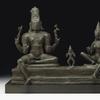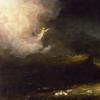Amon Carter Museum of American Art Presents Samuel F. B. Morse’s Gallery of the Louvre
- FORT WORTH, Texas
- /
- March 23, 2015
This summer, the Amon Carter Museum of American Art invites visitors to experience an iconic work of American art, Gallery of the Louvre by Samuel F. B. Morse (1791–1872). The masterwork is on a national tour organized by the Terra Foundation for American Art and is on view at the Amon Carter May 23 through August 23, 2015, in the exhibition Samuel F. B. Morse’s Gallery of the Louvre and the Art of Invention. Admission is free.
“Most people likely know Samuel Morse for his work developing the telegraph and for the code that bears his name, but he was more than a scientist—he was an important artist and educator,” says assistant curator Maggie Adler. “He exhibited at the Royal Academy of Arts in London, painted numerous portraits and history paintings, and helped found the National Academy of Design in New York City.”
In 1833, Morse completed Gallery of the Louvre, a canvas more than 6 feet tall and 9 feet wide and one he hoped would be his greatest career achievement. The painting is full of miniature renderings of the works of France’s great cultural treasure house, the Musée du Louvre.
“Morse’s ‘gallery picture,’ a form first popularized in the seventeenth century, is the only major example of such in the history of American art,” says Peter John Brownlee, curator at the Terra Foundation.
The painting was exhibited just twice in the United States; and while it received praise from critics, public audiences didn’t connect with the painting. Soon after this rejection, Morse turned his full attention to devising a means of rapid long-distance communication—an endeavor that would secure his place in history.
Now an iconic work of American art, Gallery of the Louvre depicts reduced versions of 38 paintings, two sculptures and several figures. For audiences at the time, this singular work of astounding complexity provided a summation of the history of European art, giving an opportunity for viewers to see da Vinci’s Mona Lisa, the works of Titian and Rubens, and a great Caravaggio, which they probably would have not otherwise experienced.
The paintings Morse chose to recreate in Gallery of the Louvre actually never hung together as a group in the Louvre’s Salon Carré (“square gallery”). In creating this work, Morse acted in a sort of curatorial capacity, assembling his own display of the museum’s greatest hits and conveying through his selections and juxtapositions his own theory of the history of art.
“Think of the painting as Morse’s fantasy football team or Pinterest board,” says Adler. “He chose an assemblage of artists and works that delighted and fascinated him, building on a long European tradition of paintings of fantasy galleries or painted representations of famous private collections.”
Morse’s Gallery will be displayed along with artworks from the Amon Carter’s collection, such as John Sloan’s Copyist at the Metropolitan Museum (1908) and Ruth Orkin’s photograph of Woody Allen in the galleries at the Met (1963). These supplemental works feature visitor experiences in museum and gallery spaces. A key to the painting based on Morse’s own version will be on display and enlarged so visitors can easily identify individual works.
The spirit of curating masterworks will be offered online for the Amon Carter’s Facebook followers in a virtual gallery during the run of the Morse exhibition. Participants will have the opportunity to choose their favorite works from a selection of the Amon Carter’s collection. Each month for three months the most liked images will be “exhibited” in three virtual Morse gallery spaces that mirror the backdrop of Gallery of the Louvre.
A hardcover exhibition catalogue published by Yale University Press brings together fresh insights on the painting and artist by academics, curators and conservators, who focus on the work’s visual components and the social and historical contexts that make it such a rich, complex work. It will be sold in the Amon Carter Museum Store for $45, along with a souvenir book for $14.95.
This exhibition is organized by and with support from the Terra Foundation for American Art. The Fort Worth presentation is supported in part by AZZ incorporated. The Amon Carter Museum of American Art is the second stop for the Gallery of the Louvre’s multiyear, nine-venue tour of the United States. A list of the tour cities can be found at: http://www.terraamericanart.org/2014/10/02/terra-foundation-announces-national-tour-and-published-anthology-of-american-masterpiece/
















